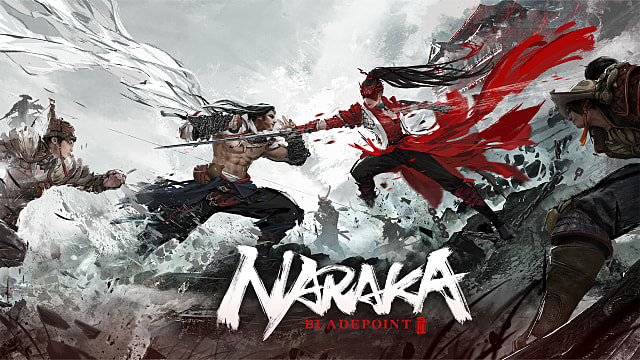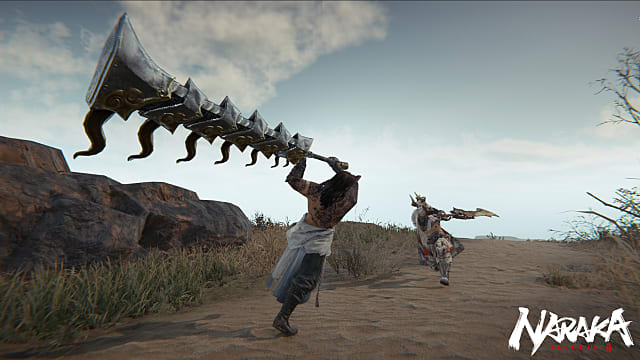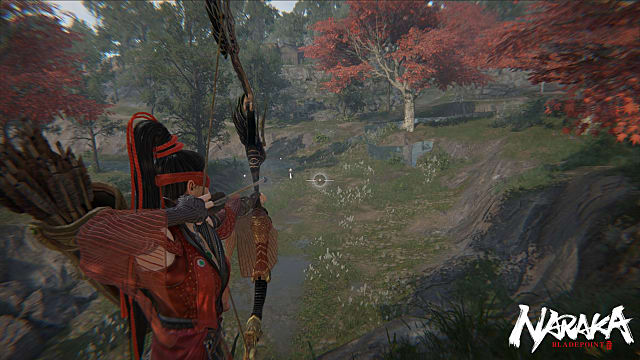But that’s where many of the similarities end.
Naraka cares very little for whatever gun skill you’ve picked up in Apex Legends or Warzone. Not only are most fights in-your-face brawls, but you’re also equipped with a grappling hook and can parkour around the map at will. You can also choose between a growing number of heroes (a term used lightly) with different abilities you’ll need to master if you want to succeed.
It’s easy to misstep with this sort of gameplay loop, but Naraka nails it. It also runs beautifully on PC, meaning you won’t be hurting for frames even on max settings. In short, Naraka is a rare combination of novel ideas and established conventions that should definitely have your attention.
Fast, Chaotic, Fun
As a melee-focused action game, Naraka’s map is significantly smaller than the maps in Apex and Warzone. The time you spend in combat vs. looting is about the same as other BRs, thanks to everyone having to run everywhere.
There are no vehicles to speak of in Naraka. Instead, you’ve got a grappling hook and the ability to climb almost everything on the map.
Grappling hooks are looted items like any other consumable, making them a valuable resource to take in the late game. The grappling system is a little finicky, where players need to let the ending animation finish before continuing, and there’s a slight delay before you can grapple as well, making its use in combat less an escape mechanism and more a tool for closing the gap or repositioning early in a fight.
You can attack at any point during a grapple and can even attach the hook to enemies if your aim is good, giving you a brief window to strike quickly and with less fear of punishment.
Regardless of how you close the distance, combat itself is usually faster than any other BR I’ve played. Once a fight starts, it tends to only end when one team is dead. A highly-skilled player could grapple away, hide, then return for his fallen friends, but because you leave behind a grave (called a cairn), a quick survey would reveal the deception.
Actual combat uses one of three melee weapons: a Sword, a Greatsword, and a Katana. Each weapon has its own moveset and upgrade path, with a special ultimate ability if you’re lucky enough to find one of the rarest Souljades, the game’s player-upgrade items.
An encounter between two newer players is likely to devolve into a spam-fest, but Naraka spices combat up by adding a counter mechanic. If you time the button presses perfectly, you’ll not only stun your opponent, you’ll also disarm them, leaving them vulnerable. You’ll also want to make liberal use of Focus Strike, a charge attack that prevents stun and deals a lot of damage. And while there are technically ranged weapons in Naraka, including a bow, gun, crossbow, and… cannon, they aren’t ever going to be your main means of fighting.
With a cast of heroes to play, any fight hinges not only on your ability to swing a sword but also use your ability and your Super effectively. Your role in the team is thus dependent on what your character can do, be it heal, disorient, distract, or destroy.
Nuts and Bolts
For those keyed into the BR genre, what I’ve just outlined sounds a bit like Apex Legends, and Naraka does owe some of its more micro details to both that game and Warzone.
Every weapon, Souljade, piece of armor, and consumable upgrade you acquire has a rarity, and their effects or stats increase with higher rarities. The color scheme is familiar, from grey at the bottom to gold at the top.
If you get your hands on some of the best items in the game, you can do things most players can’t, giving you a straight-up advantage. You’ll also be harder to kill. You’ll hit harder. And you’ll be more deadly in whatever encounter you have, no matter how one-sided.
Every weapon also has a durability value, or how many times you can use it before it deals significantly less damage. This applies to guns and bows as well, so you’ll want to have not only armor and health restoration but also weapon repair items in your backpack.
There’s also the Talent system to consider, which is a set of passive upgrades your characters unlock over time. Whenever you unlock a Talent, you can head into the Talents tree and apply it, giving your character an instant and permanent boost to their capabilities.
I could go on about the buy stations scattered around the map and the currency they use. I could talk about the hazards around the map, the tightly-designed match pacing, the revive mechanics for solo play (you get three) — I could go on for another couple thousand words examining the nuances in Naraka, but instead, I’ll end this section by talking about how the game has another mode beyond the BR component.
The alternate game mode is called The Bloodbath, and it’s basically Team Deathmatch with heroes. It won’t hold your attention long, as it’s fairly barebones (right now anyway), with a focus on taking down bounties and staying alive for long periods. It is, however, a great way to get a feel for a new character before taking them in the real meat of the game.
Bloodbath is very “instant action.” You’ll never need to look far for a fight. If you want to try out a new tactic or trick without dedicating a long time to a proper battle royale match, this mode is the way to go.
Naraka also has a training room where you use all of the weapons and Souljades in the game, learn their effects, and see which weapon type suits you best.
Final Thoughts
Naraka is very, very fun. The smaller map size and novel focus on melee combat sets it apart from almost every other entry in the genre. It’s exceedingly well-paced, and every weapon is fun to use; in the right hands, they’re capable of mass carnage.
Only two things give me a little pause: the ladder skill ranking system and the monetization element. If you’ve played any other free-to-play BR, you should see where I’m going with this.
As you play Naraka, the game scores you based on how well you do in each match, then it attempts to put you in lobbies with others of a similar skill level. The justification here is keeping new players out of the deadly clutches of veterans, likely to ensure they don’t immediately rage quit the game entirely.
It’s a valid argument, though players of the highest caliber will end up playing only other tryhards, making every game a struggle. As someone who enjoys giving a good stomp from time to time and who knows what it feels like to get my teeth kicked in, I understand the sentiment.
That said, I don’t believe there’s a reason not to have a non-ranked playlist where fun is the only goal. If you’re 100% focused for the entire match, or even most of it, burnout becomes more and more likely, as do the other issues that come from a skill-based matchmaking system.
The other issue is monetization. In short: loot boxes. Called Tidal Crates in Naraka, you need the premium currency, Gold, to unlock them. You can buy as many Crates as your gold can purchase, but you can expedite the process by buying crates in packs of 10.
Loot boxes are fairly controversial in the gaming space, but they are effective when used correctly. I think adding a premium currency on top of a loot box mechanic seems a little much, at least without a good way to spend it directly on cosmetics and other niceties.
Those two issues will likely not affect Naraka’s success. This game is carried by its amazing gameplay, incredible art style, and the many upgrades that make every game unique. It isn’t necessarily a game for shooter fans, but it isn’t trying to be, and more importantly, I think the ways Naraka breaks with convention will bring in those same players.
I’ve got high expectations of Naraka, especially as it grows and brings in new players while maintaining current ones. If you have any love for the battle royale genre, check out Naraka the first chance you get.



